In the realm of modern technology, displays have become an integral part of our daily lives. From smartphones to televisions, the clarity and vibrancy of screens are paramount. Among the various types of displays available, LCD (Liquid Crystal Display) and LED (Light Emitting Diode) technologies stand out. Understanding how these technologies work and their differences is essential for making informed choices when purchasing electronic devices.
Understanding LCD Technology
LCD technology has revolutionized the way images are displayed on screens. It utilizes liquid crystals that manipulate light to produce images. Unlike older display technologies such as CRT (Cathode Ray Tube), LCDs are thinner, lighter, and more energy-efficient. This shift not only enhanced the aesthetic appeal of devices but also contributed to the portability of modern electronics, allowing for the development of sleek laptops, tablets, and smartphones that fit comfortably in our hands and bags.
How LCD Works
At the core of an LCD is a layer of liquid crystals sandwiched between two polarizing filters. When an electric current passes through the liquid crystals, they align in such a way that allows light to pass through or be blocked, creating images. The backlight, typically provided by fluorescent lamps or LEDs, illuminates the display, allowing the viewer to see the images created by the liquid crystals. This intricate dance of light and liquid crystals is what enables LCDs to achieve remarkable clarity and detail, making them ideal for everything from high-definition televisions to smartphones.
The combination of the liquid crystals and the backlight enables LCDs to produce sharp images with a wide range of colors. However, the quality of the display can vary significantly based on the type of backlighting used and the quality of the liquid crystals themselves. Advances in technology have led to innovations such as LED backlighting, which not only enhances brightness and contrast but also allows for more energy-efficient displays. Furthermore, the introduction of technologies like local dimming has improved black levels and overall picture quality, making LCDs even more appealing for consumers.
Types of LCD Displays
There are several types of LCD displays, each with its own unique characteristics. The most common types include:
- Twisted Nematic (TN): Known for fast response times, TN panels are often used in gaming monitors. However, they typically have poorer color reproduction and viewing angles compared to other types. This makes them less suitable for tasks that require precise color accuracy, such as graphic design or photo editing.
- In-Plane Switching (IPS): IPS panels offer better color accuracy and wider viewing angles, making them popular for professional applications and multimedia consumption. They are particularly favored by photographers and videographers who need to ensure that the colors they see on screen are true to life.
- Vertical Alignment (VA): VA panels provide better contrast ratios and deeper blacks, making them suitable for watching movies in dark environments. Their ability to deliver rich, vibrant colors enhances the cinematic experience, making them a preferred choice for home theater setups.
In addition to these common types, there are also specialized LCD technologies like Super LCD (SLCD) and Advanced Fringe Field Switching (AFFS), which aim to combine the strengths of various panel types. These innovations continue to push the boundaries of what LCD technology can achieve, offering consumers even more options tailored to their specific needs and preferences. As the demand for high-quality displays grows, manufacturers are constantly exploring new materials and techniques to improve performance, durability, and energy efficiency in LCD technology.
LED Technology: A Bright Alternative
LED technology is often associated with LCDs, as it serves as a backlighting method for these displays. However, LED displays can also refer to screens that use LEDs as individual pixels, providing a different viewing experience altogether.
LED as Backlighting for LCDs
When LEDs are used as backlighting for LCDs, the result is often referred to as LED-LCD. This technology enhances the brightness and energy efficiency of traditional LCDs. LED backlighting allows for better contrast and color accuracy, significantly improving the overall viewing experience.
There are two primary types of LED backlighting: edge-lit and full-array. Edge-lit LED displays have LEDs positioned along the edges of the screen, while full-array displays have a grid of LEDs behind the entire screen. Full-array backlighting generally provides superior image quality, especially in terms of contrast and uniformity.
Furthermore, advancements in LED technology have led to the development of local dimming features in full-array displays. This allows specific zones of the backlight to dim or brighten independently, enhancing the contrast even further and providing a more dynamic range of colors. This capability is particularly beneficial for watching movies or playing video games, where dark scenes can appear more immersive and lifelike.
Direct LED Displays
In contrast to LED-LCDs, direct LED displays use individual LEDs as pixels, creating what is commonly referred to as an OLED (Organic Light Emitting Diode) display. Each pixel emits its own light, allowing for true blacks and vibrant colors. This technology has gained popularity in high-end televisions and smartphones due to its superior performance.
OLED displays can achieve higher contrast ratios than traditional LCDs because they can turn off individual pixels completely, resulting in deeper blacks. However, they can also be more expensive to produce, which can affect the overall cost of devices that use this technology.
Moreover, the flexibility of OLED technology has opened the door to innovative designs, such as curved and bendable screens. This adaptability not only enhances aesthetic appeal but also allows for new applications in various fields, from wearable technology to large-scale digital signage. As manufacturers continue to explore the potential of OLEDs, we may see even more groundbreaking developments that push the boundaries of display technology.
Comparing LCD and LED Technologies
When considering LCD and LED technologies, it is essential to understand their differences and similarities. Both technologies have their advantages and disadvantages, which can influence the choice of display for specific applications.
Image Quality
Image quality is often a primary consideration for consumers. While traditional LCDs can produce vibrant images, LED backlighting enhances this quality significantly. LED-LCDs tend to have better brightness levels and color accuracy compared to standard LCDs, making them more suitable for various lighting conditions.
On the other hand, OLED displays, which utilize direct LED technology, provide unparalleled image quality with true blacks and exceptional color reproduction. This makes them ideal for professional graphics work and high-end entertainment systems.
Energy Efficiency
Energy efficiency is another critical factor to consider. Traditional LCDs consume more power than LED-LCDs due to their reliance on fluorescent backlighting. LED backlighting not only improves brightness but also reduces energy consumption, making LED-LCDs a more environmentally friendly option.
OLED displays, while energy-efficient when displaying darker images, can consume more power when displaying bright content. Therefore, the overall energy efficiency of a display can vary based on usage patterns.
Applications of LCD and LED Displays
The applications of LCD and LED displays are vast and varied, spanning across different industries and consumer electronics. Understanding where these technologies are used can help consumers make informed decisions based on their needs.
Consumer Electronics
In consumer electronics, LCD and LED displays are ubiquitous. From televisions and computer monitors to smartphones and tablets, these technologies have become the standard for displaying high-quality visuals. LED-LCDs, in particular, are favored for their brightness and color accuracy, making them ideal for home entertainment systems.
Moreover, the lightweight and slim design of LCDs makes them suitable for portable devices, allowing for sleek designs without compromising on performance.
Industrial and Commercial Use
Beyond consumer electronics, LCD and LED displays find applications in industrial and commercial settings. Digital signage, for example, often utilizes LED displays for their brightness and visibility in outdoor environments. These displays are commonly seen in advertising, public transportation systems, and informational kiosks.
In industrial settings, LCDs are used in control panels and monitoring systems, providing clear visuals for operators to make informed decisions quickly.
Future Trends in Display Technology
The field of display technology is continuously evolving, with innovations aimed at enhancing performance and user experience. Several trends are shaping the future of LCD and LED displays.
MicroLED Technology
MicroLED is an emerging technology that combines the benefits of both LCD and OLED displays. It utilizes tiny, self-emitting LEDs to create images, offering the potential for improved brightness, contrast, and color accuracy without the drawbacks of OLED, such as burn-in issues.
This technology promises to deliver high-quality displays in a variety of form factors, from large televisions to wearable devices, making it a significant area of interest for manufacturers and consumers alike.
Flexible and Foldable Displays
Another exciting trend is the development of flexible and foldable displays. This technology allows for screens that can bend and fold without compromising image quality. Such displays open up new possibilities for device design, enabling innovative products that can adapt to different user needs.
As manufacturers continue to explore these advancements, the future of display technology looks promising, with the potential for even more immersive and versatile viewing experiences.
Conclusion
In conclusion, understanding LCD and LED display technologies is crucial for anyone looking to invest in electronic devices. Both technologies offer unique advantages and are suited for different applications. While LCDs provide a solid foundation for many consumer electronics, LED technology enhances performance and energy efficiency, making it the preferred choice for many users.
As technology continues to evolve, innovations such as MicroLED and flexible displays promise to redefine the way we interact with screens. Staying informed about these developments will help consumers make educated decisions and enjoy the best possible viewing experiences.
Whether for gaming, professional work, or casual entertainment, the right display technology can significantly enhance the overall experience. Therefore, understanding the nuances of LCD and LED technologies is not just beneficial but essential in today’s tech-driven world.
Discover Cutting-Edge LED Displays with LumenMatrix
Ready to elevate your visual experience with the latest in display technology? Look no further than LumenMatrix, a leader in LED innovation. Our extensive range of LED display modules, from vibrant Indoor and Outdoor LED Wall Displays to dynamic Vehicle and Sports LED Displays, is designed to captivate and engage your audience. Whether you’re looking to create an immersive environment with our Floor LED Display or make a bold statement with a Custom LED Display, LumenMatrix has the solution for you. Embrace the future of visual communication and check out LumenMatrix LED Display Solutions today to see how we can help your business shine.































